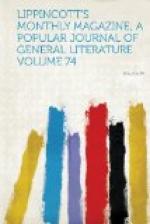at all of this. The features are small, delicately
cut, the form of face generally short, rather than
tending to oval, being in this respect also in marked
contrast with the ordinary Roman type. There is
a type of face well known to most English eyes, though
less so, I take it, to those on the western side of
the Atlantic, which is strangely recalled to the memory
by these model-girls; and that is the gypsy type.
There is the same Oriental look about them, the same
brilliancy of dark eyes under dark low brows, the
same delicately-cut noses and full yet finely-chiseled
lips. They have also almost invariably the same
wondrous wealth of long raven black tresses, glossy
but not fine. The complexions are fresher, more
delicate, and with more of bloom, than is often seen
among the gypsies; and this is the principal difference
between the two types. There is also another
point of similarity, which, if the accounts of Eastern
travelers may be accepted, seems also to point to an
Oriental origin. I allude to the singular gracefulness
of “pose” which is observable in these
people, among the men and women alike. There they
stand and lounge, or sit propped, half recumbent, against
a balustrade in the sun, in all sorts of attitudes,
but in all they are graceful. There is that indefinable
simplicity and ease in the natural movement and disposition
of their limbs which tuition can never, and birth in
the purple can so rarely, enable a European to assume.
It may perhaps be supposed that the exigencies of
their profession have not been without influence in
producing the effect I am speaking of. But I do
not think that such is the case. In the young
and the old, in the children even, the same thing
is observable; and the exceeding difficulty of teaching
it may be accepted, I think, as a guarantee that it
has not been taught in the case of creatures so unteachable
as these half-wild sons and daughters of Nature.
Now, if these people, who for generations past have
exercised the profession of artists’ models
in Rome, do really belong to a race apart from the
inhabitants of the district around Rome, as I think
cannot be doubted by any one who has carefully observed
them, the question suggests itself, Who and what are
they, and whence do they come? Fortunately, we
are not unprovided with an answer, and the answer is
rather a curious one. If the excursionist from
Rome to Tivoli will extend his ramble a little way
among the Sabine Mountains which lie behind it, up
the valley through which the Teverone—the
praeceps Anio of Horace—runs down
into the Campagna, he will see on his right hand,
when he has left Tivoli about ten miles behind him,
a most romantically situated little town on the summit
of a conically shaped mountain. The name of it
is Saracinesco, and its story is as curious as its
situation. It is said—and the tradition
has every appearance of truth—that the
town was founded by a body of Saracens after their
defeat by Berengarius in the ninth century. The




